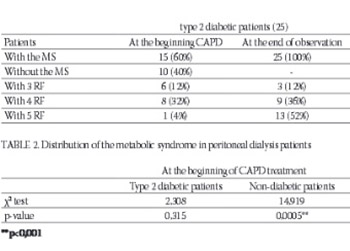The Metabolic Syndrome in Patients in Peritoneal Dialysis: Prevalence and Influence on Cardiovascular Morbidity
DOI:
https://doi.org/10.17305/bjbms.2010.2638Keywords:
peritoneal dialysis, metabolic syndrome, cardiovascular morbidityAbstract
The metabolic syndrome (MS) is a multi-factorial disorder which includes a main risk factors associated with the development of cardiovascular, neurologic, renal and endocrine diseases, especially type 2 diabetes. This study has been conducted to estimate the prevalence of the MS in patients undergoing continuous ambulatory peritoneal dialysis (CAPD) and its association with cardiovascular morbidity. The study included 37 patients (25 type 2 diabetic patients and 12 non-diabetic patients), who had been on peritoneal dialysis for > 3 months. At the beginning of CAPD treatment (baseline) and at the end of follow-up, we measured: body mass index (BMI), blood pressure, fasting blood glucose, triglycerides and high-density lipoprotein cholesterol (HDLC) and defined the prevalence of the MS using the modified National Cholesterol Education Program (NCEP; Adult Treatment Panel III) for peritoneal dialysis patients. The overall prevalence of the MS was 89,2%. The metabolic syndrome was estimated in all (100%) type 2 diabetic patients (vs. 60% patients on the beginning of CAPD treatment). In non-diabetic peritoneal patients, the MS was estimated in 50% cases, according to 33,3% at the beginning CAPD treatment. Development of the MS was significantly higher in the type 2 diabetic patients in compared with non-diabetic patients until the end of follow-up examination (p=0,0005). The prevalence of LVH in type 2 diabetic patients with the MS was significantly higher (p=0,002) than in non-diabetic peritoneal patients with the MS. We didn’t found statistical significantly difference in the prevalence of ischemic heart disease between this two category of peritoneal dialysis patients (p=0,076). The results indicate that the metabolic syndrome is presented in high percentage in peritoneal dialysis patients, and it’s also important risk factor of high cardiovascular morbidity rate in these patients, especially in type 2 diabetic patients.
Citations
Downloads

Published
Issue
Section
Categories
How to Cite
Accepted 2017-11-10
Published 2010-04-20









